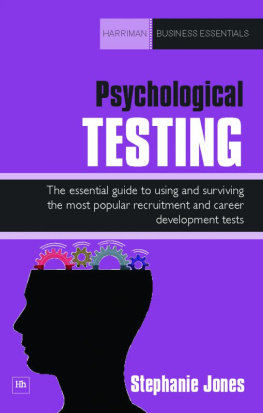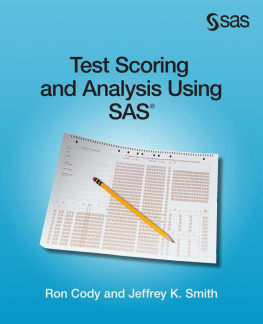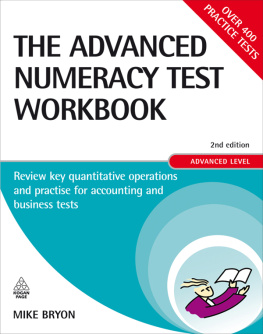
Psychology Revivals
A Handbook of Test Construction
Psychological tests provide reliable and objective standards by which individuals can be evaluated in education and employment. Therefore accurate judgements must depend on the reliability and quality of the tests themselves. Originally published in 1986, this handbook by an internationally acknowledged expert provided an introductory and comprehensive treatment of the business of constructing good tests.
Paul Kline shows how to construct a test and then to check that it is working well. Covering most kinds of tests, including computer presented tests of the time, Rasch scaling and tailored testing, this title offers: a clear introduction to this complex field; a glossary of specialist terms; an explanation of the objective of reliability; step-by-step guidance through the statistical procedures; a description of the techniques used in constructing and standardizing tests; guidelines with examples for writing the test items; computer programs for many of the techniques.
Although the computer testing will inevitably have moved on, students on courses in occupational, educational and clinical psychology, as well as in psychological testing itself, would still find this a valuable source of information, guidance and clear explanation.
A Handbook of
Test Construction
Introduction to psychometric design
Paul Kline

First published in 1986
by Methuen & Co. Ltd
This edition first published in 2015 by Routledge
27 Church Road, Hove BN3 2FA
and by Routledge
711 Third Avenue, New York, NY 10017
Routledge is an imprint of the Taylor & Francis Group, an informa business
1986 Paul Kline
Computer programs in appendices 1986 Colin Cooper
The right of Paul Kline to be identified as author of this work has been asserted by him in accordance with sections 77 and 78 of the Copyright, Designs and Patents Act 1988.
All rights reserved. No part of this book may be reprinted or reproduced or utilised in any form or by any electronic, mechanical, or other means, now known or hereafter invented, including photocopying and recording, or in any information storage or retrieval system, without permission in writing from the publishers.
Publishers Note
The publisher has gone to great lengths to ensure the quality of this reprint but points out that some imperfections in the original copies may be apparent.
Disclaimer
The publisher has made every effort to trace copyright holders and welcomes correspondence from those they have been unable to contact.
A Library of Congress record exists under ISBN: 0416394205
ISBN: 978-1-138-90511-5 (hbk)
ISBN: 978-1-315-69599-0 (ebk)
PAUL KLINE
A Handbook of Test Construction
Introduction to psychometric design
Methuen
First published in 1986 by
Methuen & Co. Ltd
11 New Fetter Lane, London EC4P 4EE
Published in the USA by
Methuen & Co.
in association with Methuen, Inc.
29 West 35th Street, New York NY 10001
1986 Paul Kline
Computer programs in appendices 1986 Colin Cooper
Typeset by MC Typeset, Chatham, Kent
Printed in Great Britain
at the University Press, Cambridge
All rights reserved. No part of this book may be reprinted or reproduced or utilized in any form or by any electronic, mechanical or other means, now known or hereafter invented, including photocopying and recording, or in any information storage or retrieval system, without permission in writing from the publishers.
British Library Cataloguing in Publication Data
Kline, Paul
A handbook of test construction: introduction to psychometric design.
1. Psychological tests
I. Title
150728. BF176
ISBN 0-416-39420-5
ISBN 0-416-39430-2 Pbk
Library of Congress Cataloging in Publication Data
Kline, Paul
A handbook of test construction.
Bibliography: p.
Includes index.
1. Psychological testsDesign and construction.
2. Educational testsDesign and construction.
3. Employment testsDesign and construction. I. Title.
BF176.K578 1986 150.287 86-12878
ISBN 0-416-39420-5
ISBN 0-416-39430-2 (pbk.)
Contents
This book has been given the title A Handbook of Test Construction to indicate its essentially practical aim. It is intended to be a guide, a vade-mecum for anybody who needs to construct a psychological test.
It contains an introductory theoretical chapter explicating the statistical rationale of the methods of test construction which are described in the text. This is to ensure that there is understanding, not blind obedience to dogma. Such understanding should also enable, it is hoped, the user of the handbook to modify sensibly any of the procedures in the light of his particular needs.
This book seeks to help the test constructor not only to execute the psychometric techniques necessary for adequate test construction but also to stimulate his production of test items. This is really an art, even though there are useful rules and guidelines, but it is one well worth cultivating since in the end the quality of a test is bounded by the quality of its items.
Finally I want to say a word about the computer programs included in this book. First I want to thank my colleague Dr Colin Cooper, who has worked with me on many research projects, for especially writing these programs. He is an expert programmer and statistician, and has produced a suite of programs which allow the user to carry out most of the statistical techniques described in this handbook. These have been rendered as foolproof as is reasonable (it is doubtful whether a truly foolproof program could ever be written), and they are capable of handling quite large data sets. Thus, armed with the handbook and the programs, a reader can construct and validate a test. In addition, the programs are useful for readers who want to try out the techniques described with a little trial data.
I have also set out the computational steps for many of the psychometric techniques in an effort to curb the frightening dependence on computer programs that many social scientists have developed. In examining PhDs at many universities, I find complex and outlandish statistical techniques used by students with only minimal insight. This can only be a bad development for psychology hence the often laborious explanations of what has to be done, as well as the computer program.
Paul Kline
Department of Psychology
University of Exeter
April 1986
Biserial correlation This is the coefficient suitable for a continuous variable to be correlated with a dichotomized variable (e.g. passfail where the distribution is essentially continuous).
Communality The proportion of variance accounted for by a set of factors.
Concurrent validity This is measured by the correlation of a test with other tests purporting to measure the same variable.
Construct validity The more the results of a test fit the hypotheses that can be made about them, from the nature of the variable (i.e. the construct), the higher the construct validity of that test.
Correlation An index of the degree of relationship between two variables. It runs from 1 to +1. A correlation of 0 indicates no relationship; +1 shows perfect agreement.
Correlation matrix A set of correlations between variables. The resulting rows and columns of correlation coefficients contribute to the matrix.
Next page












